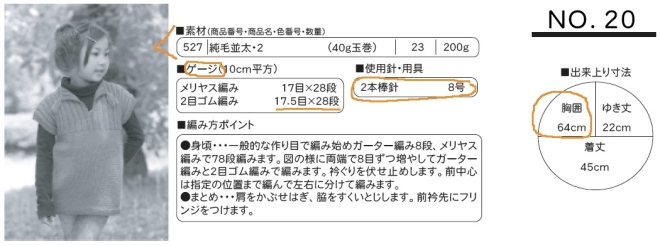Welcome to my first attempt at a Japanese pattern-reading tutorial! This is meant to be a KAL/CAL type tutorial, so grab those hooks and needles and join in.
First things first: the patterns we’ll be starting with are one small crochet project and one small knitting project. These were chosen to help people get a feel for charted pattern reading without having to invest in a long-term project. Feel free to do just one or both. Our crochet pattern will be 29-210-28 Pop Merino Beret (Ravelry link) and our knitting pattern will be 26-27-20 Child’s Sweater (Ravelry link). Thanks are due to Pierrot Yarns for allowing me to use their patterns for this tutorial.
So, let’s get started. What do you need to know to start a charted Japanese pattern? Well, chances are, identifying the suggested yarn, hook/needle, and gauge is a good place to start. For Japanese patterns that are on Ravelry, of course, you can often find this information on the pattern’s Ravelry page in English. But you probably want to know how to figure it out from the pattern itself, right?
Step 1: Don’t panic! It’s just a pattern.
Step 2: Know where to look. In Japanese patterns, 99% of the time, you’ll find all the information about yarn, hook or needle, gauge, and finished measurements up at the top of the pattern. Got your crochet beret pattern handy? Let’s see what we’ve got:

The part circled in blue is where all the important information is. The part crossed out in red may look important, but it very rarely is. It’s just a short description of how the pattern is worked. For example, in a sweater pattern, it may say something as earth-shattering as “make back, make front, make two sleeves, sew together” – not so important, right? You can already get all that information from the charts and diagrams.
I can already hear someone saying, well, when should you pay attention to the Japanese blurb? My own opinion is that pretty much the only time the blurb is useful is when it instructs you to use more than one strand of yarn at the same time. Luckily, this is pretty easy to figure out. Check the blurb for 2本どり. Do you see it? If so, you’re supposed to be using 2 strands of yarn at the same time. (It could be 3本どり in rare cases using 3 strands at once.) If not, it’s just 1 strand of yarn. There’s no 2本どり in the beret pattern, and if you check the sweater pattern, you won’t find it either. So now we know that we’re making both of these patterns with one strand each.
Step 3: Know what to look for. It’s not fancy, but I’ve marked the important parts of the materials list. Here’s the beret:

And here’s the sweater:

Already this post is getting too long, so I’ll just make it short and tell you the crucial info. I’ll go into more detail about this stuff later – so that you can figure it out for yourself – but for now, I just wanted to help people figure out what materials they’ll need for the tutorial.
This is what you should know for the beret:
- 85g Pop Merino
- (Japanese) size 7/0 crochet hook (check out snuffykins’ helpful chart and you’ll see that this is a 4.0mm hook, which is a US size G.)
- size: head circumference 45cm (that’s 17.7 inches)
- gauge: 15 st and 8.5 rows in pattern stitch
- gauge measurements unless otherwise noted are for a 10cm by 10cm swatch – you can see that it says 10cm平方, which confirms the 10cm size here)
For the sweater, the crucial info is:
- 200g Junmo Namibuto2
- (Japanese) size 8 knitting needles (for knitting needles, get metric sizes from the ABCs of Knitting website – these are size 4.5mm, which is US 7)
- gauge: two are listed
- stockinette: 17 st and 28 rows (again, in a 10cm by 10cm swatch)
- pattern stitch: 17.5 st and 28 rows
- size: chest 64cm (25.2 inches)
Step 4: If all else fails, remember that Ravelry is a great resource. There’s no shame in asking if someone else can identify the yarn for you. The Japanese knitting and crochet group is an excellent place to ask.
Please let me know if you have any questions. I’ll do the next lesson later in the week, but it’ll be about resources that help with charted patterns. We’ll start the actual knitting & crocheting next week, which should give everyone time to gather the materials they need. I’m thinking of doing tutorials for the crochet pattern on Mondays and for the knitting pattern on Thursdays. Does that work for everyone?











